Category
Sports Photography
3 entries in this category | view all categories
I am America
Posted June 2020 in Significant Photographers, Significant Photographs, Sports Photography
“I am America. I am the part you won’t recognize. But get used to me—black, confident, cocky; my name, not yours; my religion, not yours; my goals, my own. Get used to me.” ― Muhammad Ali
Remember his name: George Floyd
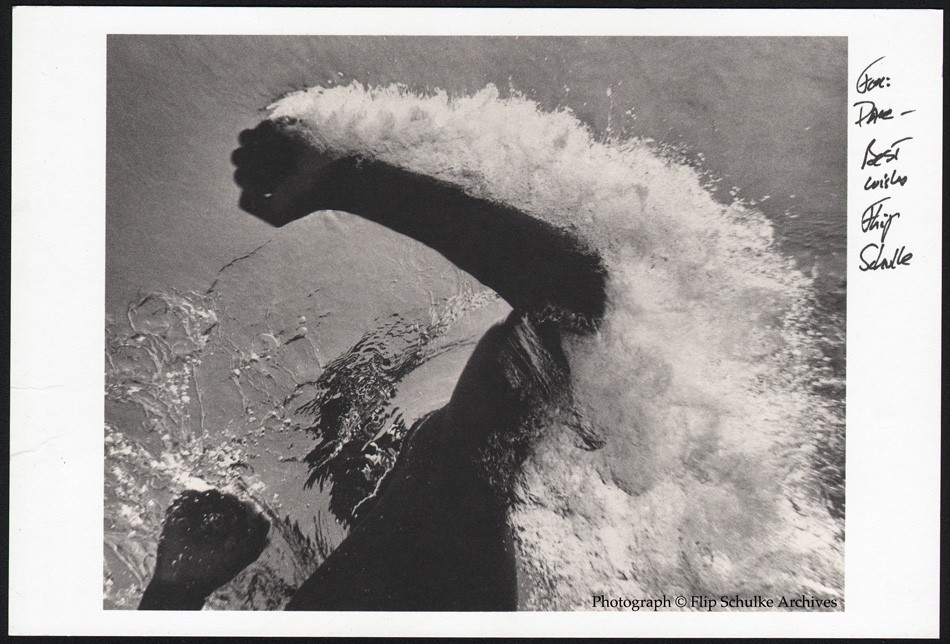 “Left Hook” (Muhammad Ali training underwater): Graeme Phelps "Flip" Schulke, American: 1930-2008: Fine Halftone ca. 1994 on manilla cardstock from original 1961 copy or source negative or print: 14.6 x 21.6 cm. (overall) Used here as a promotional gallery card for the New York City based James Danziger show: “Sport Stories: Sports photographs from 1900 to today”- February 18 - March 12, 1994. “Left Hook” was one of a series of photographs of boxer Muhammad Ali (then known as Cassius Clay) training underwater taken by American photojournalist Flip Schulke in the swimming pool of Miami’s Sir John Hotel in August, 1961. The photograph was first published of the then 19 year-old fighter in the September 8, 1961 weekly issue of Life magazine as part of a two-page spread titled “A Wet Way to Train for a Fight”. Schulke, an accomplished underwater photographer, donned Scuba gear and an underwater camera to make these photographs, learning three years later to his delight that Ali did not know how to swim at the time: “Boy, to con Life magazine! I never had an inkling that I had been taken. …To me, it shows his genius.” the photographer said for his volume “Muhammad Ali: the Birth of a Legend, Miami, 1961-1964” published in 2000. Photograph © Flip Schulke Archives. Gallery card from collection of PhotoSeed site owner signed by Schulke in 1999.
“Left Hook” (Muhammad Ali training underwater): Graeme Phelps "Flip" Schulke, American: 1930-2008: Fine Halftone ca. 1994 on manilla cardstock from original 1961 copy or source negative or print: 14.6 x 21.6 cm. (overall) Used here as a promotional gallery card for the New York City based James Danziger show: “Sport Stories: Sports photographs from 1900 to today”- February 18 - March 12, 1994. “Left Hook” was one of a series of photographs of boxer Muhammad Ali (then known as Cassius Clay) training underwater taken by American photojournalist Flip Schulke in the swimming pool of Miami’s Sir John Hotel in August, 1961. The photograph was first published of the then 19 year-old fighter in the September 8, 1961 weekly issue of Life magazine as part of a two-page spread titled “A Wet Way to Train for a Fight”. Schulke, an accomplished underwater photographer, donned Scuba gear and an underwater camera to make these photographs, learning three years later to his delight that Ali did not know how to swim at the time: “Boy, to con Life magazine! I never had an inkling that I had been taken. …To me, it shows his genius.” the photographer said for his volume “Muhammad Ali: the Birth of a Legend, Miami, 1961-1964” published in 2000. Photograph © Flip Schulke Archives. Gallery card from collection of PhotoSeed site owner signed by Schulke in 1999.
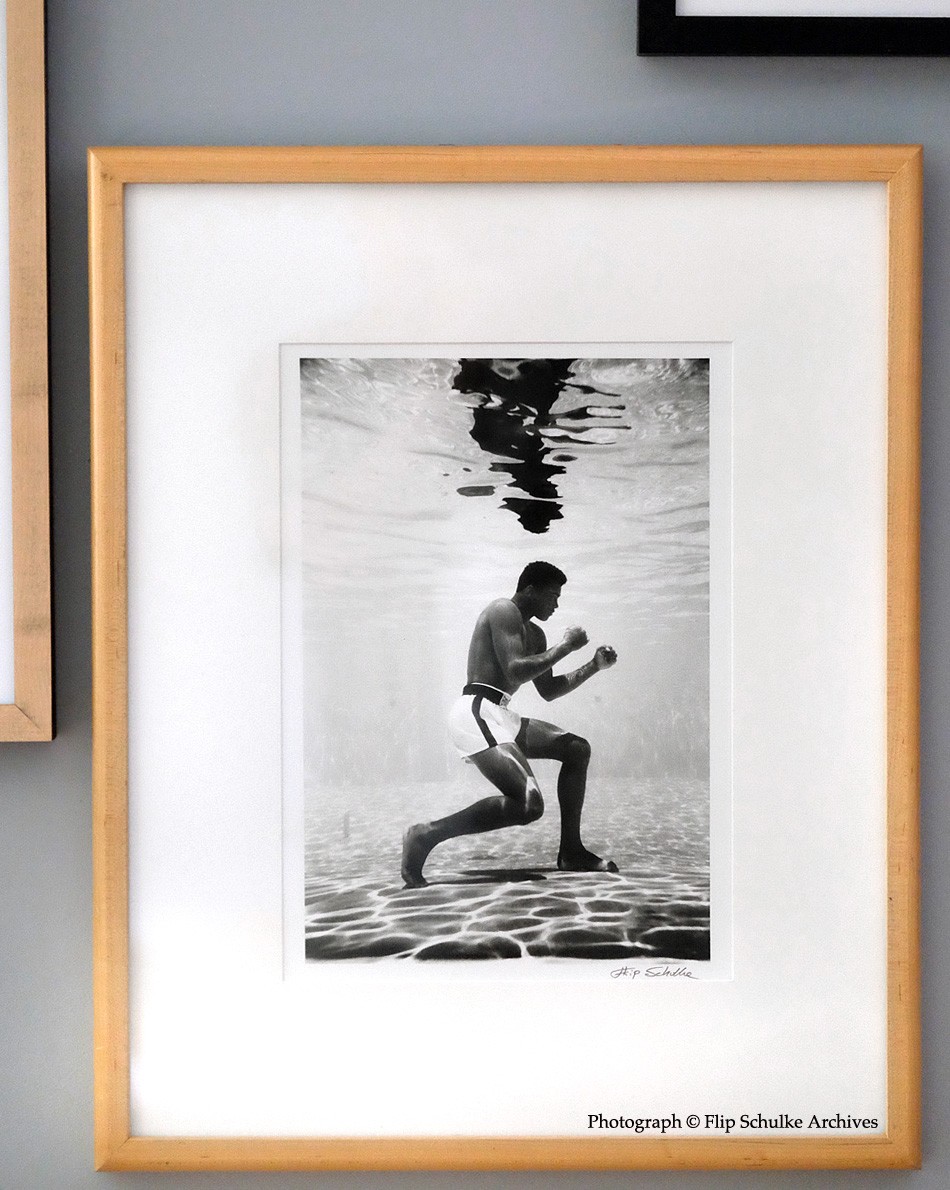 “Ali Underwater”: Graeme Phelps "Flip" Schulke, American: 1930-2008: Gelatin Silver print ca. 1999 from original 1961 source negative: 31.5 x 21.1 | 35.2 x 27.9 cm. Flip Schulke’s iconic photograph of boxer Muhammad Ali holding his breath while assuming a traditional boxing stance was one of a series of the world champion (then known as Cassius Clay) training underwater in the swimming pool of Miami’s Sir John Hotel in August, 1961. “For the picture of him standing on the bottom of the pool, he just sank down and stood on the bottom. It’s hard to do. I didn’t ask him to do it, I didn’t put any weights on him or anything. He exhaled all of his air-that’s the only way you can sink down.” the photographer said for his volume “Muhammad Ali: the Birth of a Legend, Miami, 1961-1964” published in 2000. Flip Schulke was a close friend of American Civil Rights icon Dr. Martin Luther King Jr. , and he spent more than a decade covering the movement for national magazines including Life, Time and Newsweek. These photographs were featured in three volumes by him: "Martin Luther King, Jr.: A Documentary, Montgomery to Memphis" (1976); "King Remembered" (1986); and "He Had A Dream" (1995). Other volumes by the photographer include "Underwater Photography for Everyone" (1979); "Your Future in Space: The U.S. Space Camp Training Program" (1986); "Muhammad Ali: the Birth of a Legend, Miami, 1961-1964" (2000); and "Witness to Our Times: My Life as a Photojournalist" (2003). Photograph © Flip Schulke Archives. Framed photograph from PhotoSeed Archive.
“Ali Underwater”: Graeme Phelps "Flip" Schulke, American: 1930-2008: Gelatin Silver print ca. 1999 from original 1961 source negative: 31.5 x 21.1 | 35.2 x 27.9 cm. Flip Schulke’s iconic photograph of boxer Muhammad Ali holding his breath while assuming a traditional boxing stance was one of a series of the world champion (then known as Cassius Clay) training underwater in the swimming pool of Miami’s Sir John Hotel in August, 1961. “For the picture of him standing on the bottom of the pool, he just sank down and stood on the bottom. It’s hard to do. I didn’t ask him to do it, I didn’t put any weights on him or anything. He exhaled all of his air-that’s the only way you can sink down.” the photographer said for his volume “Muhammad Ali: the Birth of a Legend, Miami, 1961-1964” published in 2000. Flip Schulke was a close friend of American Civil Rights icon Dr. Martin Luther King Jr. , and he spent more than a decade covering the movement for national magazines including Life, Time and Newsweek. These photographs were featured in three volumes by him: "Martin Luther King, Jr.: A Documentary, Montgomery to Memphis" (1976); "King Remembered" (1986); and "He Had A Dream" (1995). Other volumes by the photographer include "Underwater Photography for Everyone" (1979); "Your Future in Space: The U.S. Space Camp Training Program" (1986); "Muhammad Ali: the Birth of a Legend, Miami, 1961-1964" (2000); and "Witness to Our Times: My Life as a Photojournalist" (2003). Photograph © Flip Schulke Archives. Framed photograph from PhotoSeed Archive.March Madness: Old School
Posted March 2020 in Alternate Processes, Documentary Photography, Sports Photography, Unknown Photographers
March Madness, the fanciful right of passage in the U.S. crowning a men’s and women’s national collegiate basketball champion, got cancelled this year. Instead, this aforesaid Madness has become a perfect descriptor for a reality that is the ongoing global pandemic caused by the COVID-19 coronavirus. Obviously, what little PhotoSeed contributes during this time of uncertainty are mere diversions, yet ones curated with the intent of promoting positivity for our shared love of the universal language that is Photography.
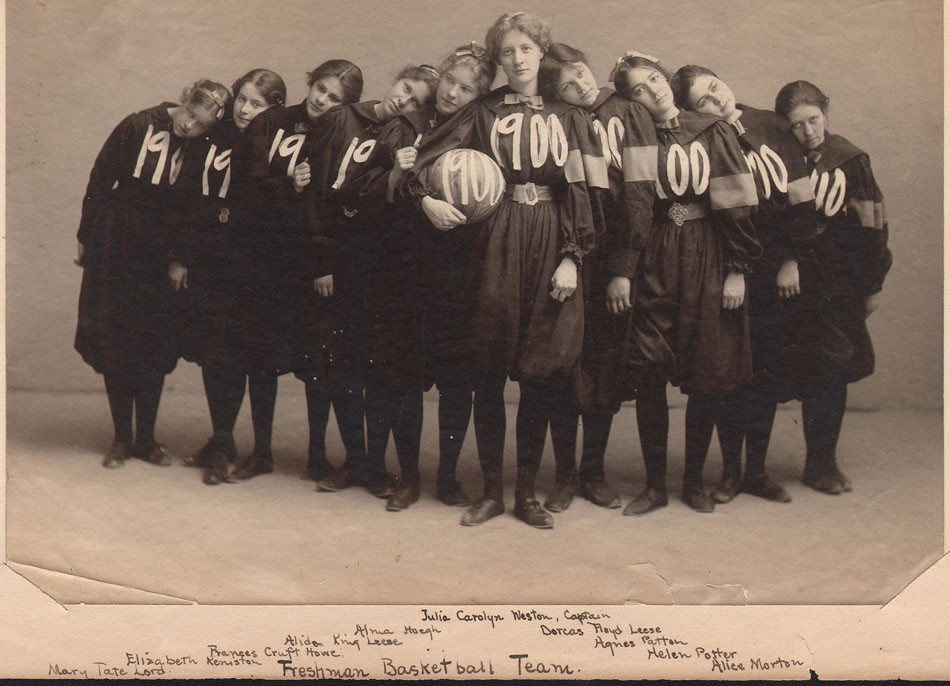 Detail: “Freshman Basket ball Team” (Smith College) Unknown American commercial photographer (possibly Amand Joseph “A.J. Schillare: 1856-1917 of Northampton who advertised “groups and dramatics a specialty” in the 1899 Class Book): Gelatin Silver print: ca. 1897 (15.9 x 21.1 cm | 18.2 x 27.5 cm loosely inserted within thin, manilla album leaf) These ten young women made up the Smith College Basket Ball Team for the 1900 graduating class. The photograph was taken approximately 4 years earlier, when they would have been freshmen. At center holding the ball is team captain Julia Carolyn Weston, (1877-1937) whose future daughter, Julia Child, (1912-2004: Smith College, class of 1934) became the legendary chef and famed American television personality. Known by her nickname “Caro”, Julia Weston was “known for her red hair, outspoken opinions, and sense of humor.” (source: Julia Child: My Life in France) This unique photograph is further annotated on the verso in graphite by team members in their own hand. Players left to right: Mary Tate Lord, Elizabeth Keniston, Frances Cruft Howe, Alida King Leese, Alma Hoegh, Carolyn Weston, Dorcas Floyd Leese, Agnes Patton, Helen Potter, Alice Morton. From: PhotoSeed Archive
Detail: “Freshman Basket ball Team” (Smith College) Unknown American commercial photographer (possibly Amand Joseph “A.J. Schillare: 1856-1917 of Northampton who advertised “groups and dramatics a specialty” in the 1899 Class Book): Gelatin Silver print: ca. 1897 (15.9 x 21.1 cm | 18.2 x 27.5 cm loosely inserted within thin, manilla album leaf) These ten young women made up the Smith College Basket Ball Team for the 1900 graduating class. The photograph was taken approximately 4 years earlier, when they would have been freshmen. At center holding the ball is team captain Julia Carolyn Weston, (1877-1937) whose future daughter, Julia Child, (1912-2004: Smith College, class of 1934) became the legendary chef and famed American television personality. Known by her nickname “Caro”, Julia Weston was “known for her red hair, outspoken opinions, and sense of humor.” (source: Julia Child: My Life in France) This unique photograph is further annotated on the verso in graphite by team members in their own hand. Players left to right: Mary Tate Lord, Elizabeth Keniston, Frances Cruft Howe, Alida King Leese, Alma Hoegh, Carolyn Weston, Dorcas Floyd Leese, Agnes Patton, Helen Potter, Alice Morton. From: PhotoSeed Archive
Today’s post concerns the early history of women’s basketball, a game commonly spelled in the late 19th and early 20th centuries as two words: “basket ball”. What follows are a series of vintage photographs ✻ from the PhotoSeed archive showcasing the origins of the collegiate game as it evolved on the campus of Smith College in Northampton, Massachusetts.
It was here, in 1892, less than one year after James Naismith invented the game in nearby Springfield, that newly appointed Smith College school gymnastics instructor Senda Berenson Abbott (1868-1954) would adapt the rules of the new game for women. By 1893, she had organized the first college game in history, between players from the sophomore class of 1895 and the freshman class of 1896. In so doing, Berenson changed history, and forever became known as the “Mother of Women’s Basketball”. A wonderful video on the dawn of the game at Smith featuring Senda’s accomplishments was written and produced by Kate Lee and can be found here on YouTube. Another link shows the earliest known film footage of the game played at Missouri Valley College in 1904. Enjoy our gallery! -David Spencer
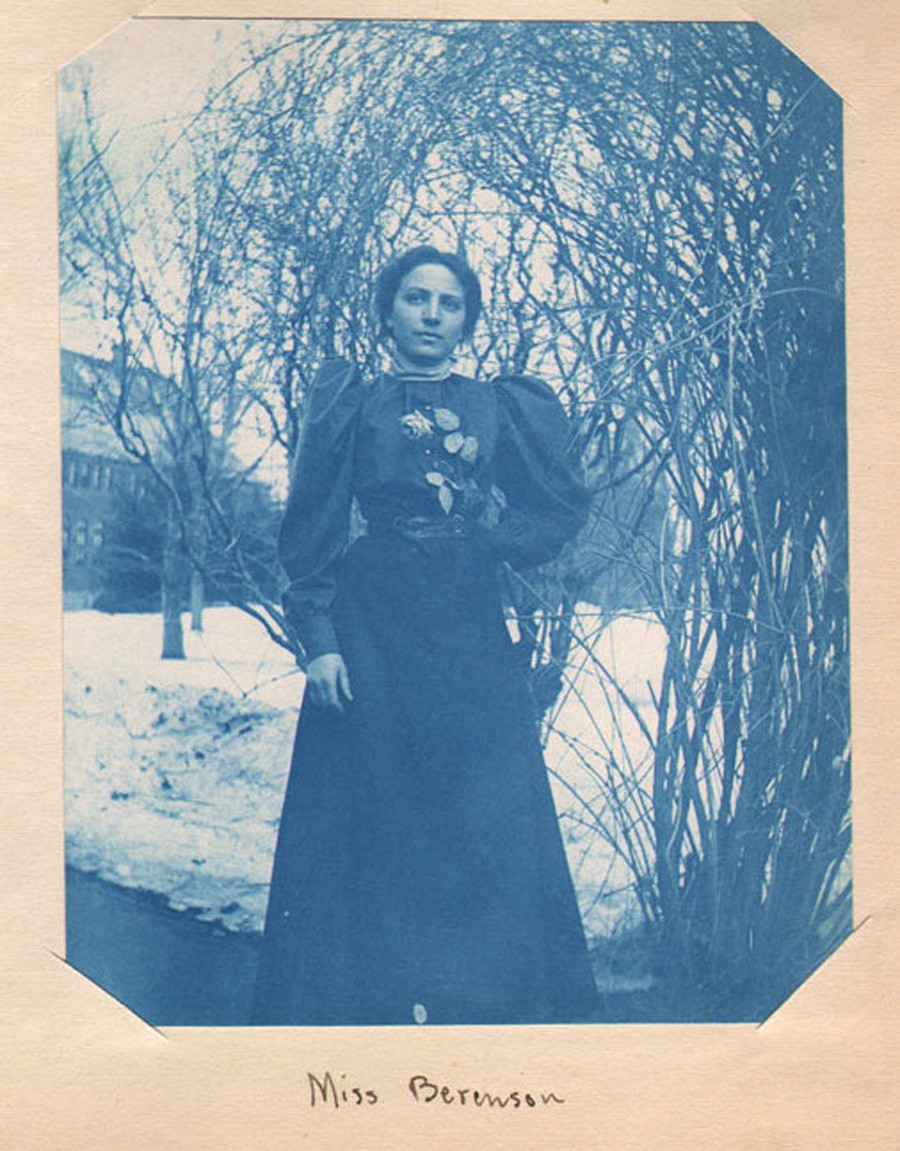 "Miss Berenson” (Senda Berenson Abbott: 1868-1954) Unknown American photographer: cyanotype: ca. 1897-99 (11.5 x 9.0 cm | 18.2 x 27.5 cm loosely inserted within thin, manilla album leaf) Known as the ‘’Mother of Women's Basketball'' Berenson was first hired as a gymnastics instructor at Smith College before becoming the Director of the Gymnasium and Instructor of Physical Culture there, adapting the first rules of women's basketball in 1892. The game had been invented less than a year earlier by James Naismith in nearby Springfield, Mass. By 1899, Berenson had codified her rules for the women’s game, and in 1901, they were published in the volume “Basket Ball for Women” by Spalding’s Athletic Library. From: PhotoSeed Archive
"Miss Berenson” (Senda Berenson Abbott: 1868-1954) Unknown American photographer: cyanotype: ca. 1897-99 (11.5 x 9.0 cm | 18.2 x 27.5 cm loosely inserted within thin, manilla album leaf) Known as the ‘’Mother of Women's Basketball'' Berenson was first hired as a gymnastics instructor at Smith College before becoming the Director of the Gymnasium and Instructor of Physical Culture there, adapting the first rules of women's basketball in 1892. The game had been invented less than a year earlier by James Naismith in nearby Springfield, Mass. By 1899, Berenson had codified her rules for the women’s game, and in 1901, they were published in the volume “Basket Ball for Women” by Spalding’s Athletic Library. From: PhotoSeed Archive
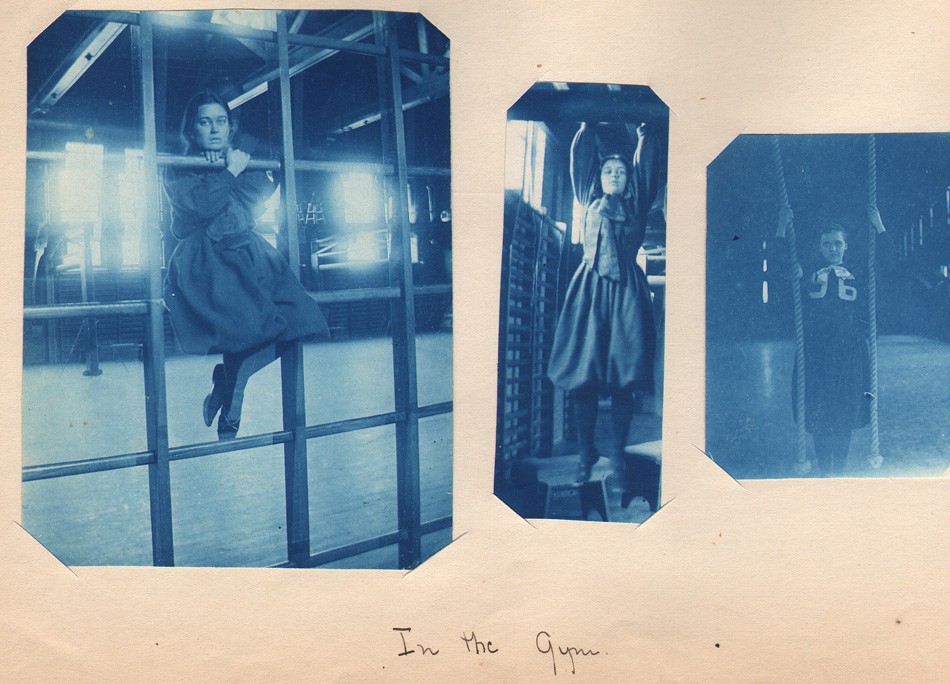 “In the Gym” (Smith College: Northampton, Mass.) Unknown American photographer(s): cyanotypes: ca. 1897-99 (L: 11.9 x 9.1 cm | M: 9.3 x 3.5 cm | R: Detail: 7.3 x 9.7 cm) (18.2 x 27.5 cm loosely inserted within thin, manilla album leaf) Smith College students using the exercise and gymnastics equipment in Alumnae Gymnasium on campus are shown. Physical education for women was an important component of a collegiate education at Smith, especially after the college had built this new facility in 1890, one of the finest of its’ type in the country. Public sentiment however, beginning from Senda Berenson’s early tenure at Smith in the early 1890’s, was something she pushed back against- with obvious success. From her Wikipedia page: “Although the physical facilities were in fine shape, the notion that women should engage in physical exercise, much less be required to do so, was not then well-established. The prevailing atmosphere did not support the notion that women should engage in physical activity. Berenson would write, in 1894: “Until recent years, the so-called ideal woman was a small waisted, small footed, small brained damsel, who prided herself on her delicate health, who thought fainting interesting, and hysterics fascinating.” From: PhotoSeed Archive
“In the Gym” (Smith College: Northampton, Mass.) Unknown American photographer(s): cyanotypes: ca. 1897-99 (L: 11.9 x 9.1 cm | M: 9.3 x 3.5 cm | R: Detail: 7.3 x 9.7 cm) (18.2 x 27.5 cm loosely inserted within thin, manilla album leaf) Smith College students using the exercise and gymnastics equipment in Alumnae Gymnasium on campus are shown. Physical education for women was an important component of a collegiate education at Smith, especially after the college had built this new facility in 1890, one of the finest of its’ type in the country. Public sentiment however, beginning from Senda Berenson’s early tenure at Smith in the early 1890’s, was something she pushed back against- with obvious success. From her Wikipedia page: “Although the physical facilities were in fine shape, the notion that women should engage in physical exercise, much less be required to do so, was not then well-established. The prevailing atmosphere did not support the notion that women should engage in physical activity. Berenson would write, in 1894: “Until recent years, the so-called ideal woman was a small waisted, small footed, small brained damsel, who prided herself on her delicate health, who thought fainting interesting, and hysterics fascinating.” From: PhotoSeed Archive
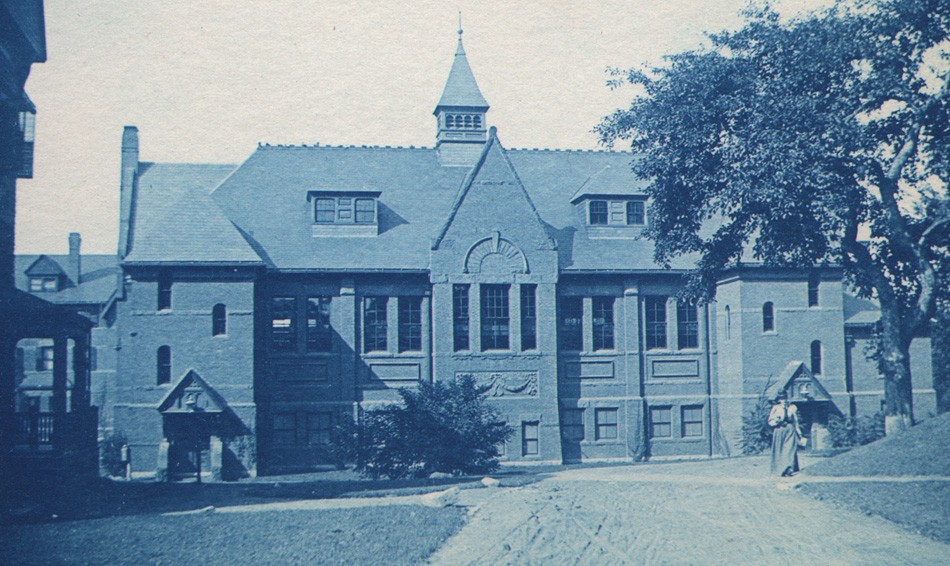 Detail: “The Alumnae Gymnasium” (Smith College: Northampton, Mass.) Unknown American photographer: cyanotype: ca. 1897-1900 (9.3 x 12.0 cm | 18.2 x 27.5 cm loosely inserted within thin, manilla album leaf) It was in this building that the first women’s college basketball game in history took place on March 22, 1893 between players from the Smith College sophomore class of 1895 and the freshman class of 1896. The sophomores won, 5-4, during two, 15-minute halves under Naismith rules. The Late Gothic style building was built from red brick with brownstone trim and designed by architect William C. Brocklesby of Hartford, CT. Today it houses the Smith College Archives, and was saved from demolition in 1977 when it was moved 200’ from its original location in order to comply with a campus expansion. From: PhotoSeed Archive
Detail: “The Alumnae Gymnasium” (Smith College: Northampton, Mass.) Unknown American photographer: cyanotype: ca. 1897-1900 (9.3 x 12.0 cm | 18.2 x 27.5 cm loosely inserted within thin, manilla album leaf) It was in this building that the first women’s college basketball game in history took place on March 22, 1893 between players from the Smith College sophomore class of 1895 and the freshman class of 1896. The sophomores won, 5-4, during two, 15-minute halves under Naismith rules. The Late Gothic style building was built from red brick with brownstone trim and designed by architect William C. Brocklesby of Hartford, CT. Today it houses the Smith College Archives, and was saved from demolition in 1977 when it was moved 200’ from its original location in order to comply with a campus expansion. From: PhotoSeed Archive
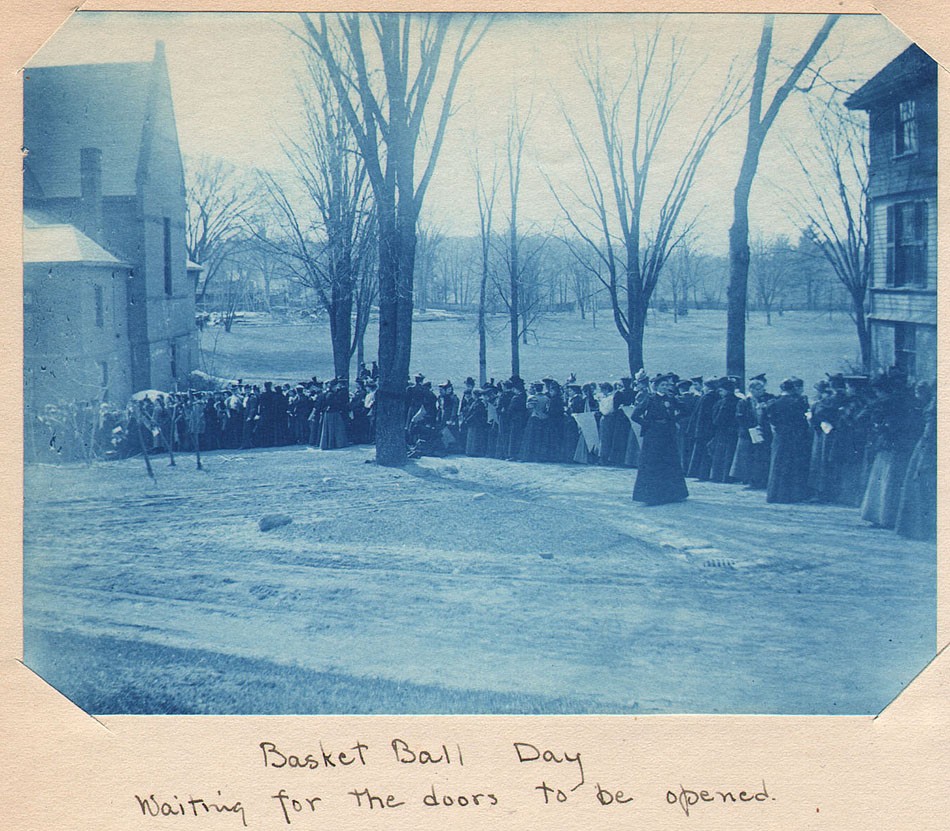 “Basket Ball Day - Waiting for the Doors to be Opened” (Smith College: Northampton, Mass.) Unknown American photographer: cyanotype: ca. 1897-1900 (9.4 x 12.3 cm | 18.2 x 27.5 cm loosely inserted within thin, manilla album leaf) With some students holding class pennants used to cheer their team on, a long line of Smith women’s basketball fans wait two and three deep for the doors to be opened at Alumnae Gymnasium at far left. At far right is the former gym, a much smaller wooden structure, which originally opened in 1879 soon after the school opened. From: PhotoSeed Archive
“Basket Ball Day - Waiting for the Doors to be Opened” (Smith College: Northampton, Mass.) Unknown American photographer: cyanotype: ca. 1897-1900 (9.4 x 12.3 cm | 18.2 x 27.5 cm loosely inserted within thin, manilla album leaf) With some students holding class pennants used to cheer their team on, a long line of Smith women’s basketball fans wait two and three deep for the doors to be opened at Alumnae Gymnasium at far left. At far right is the former gym, a much smaller wooden structure, which originally opened in 1879 soon after the school opened. From: PhotoSeed Archive
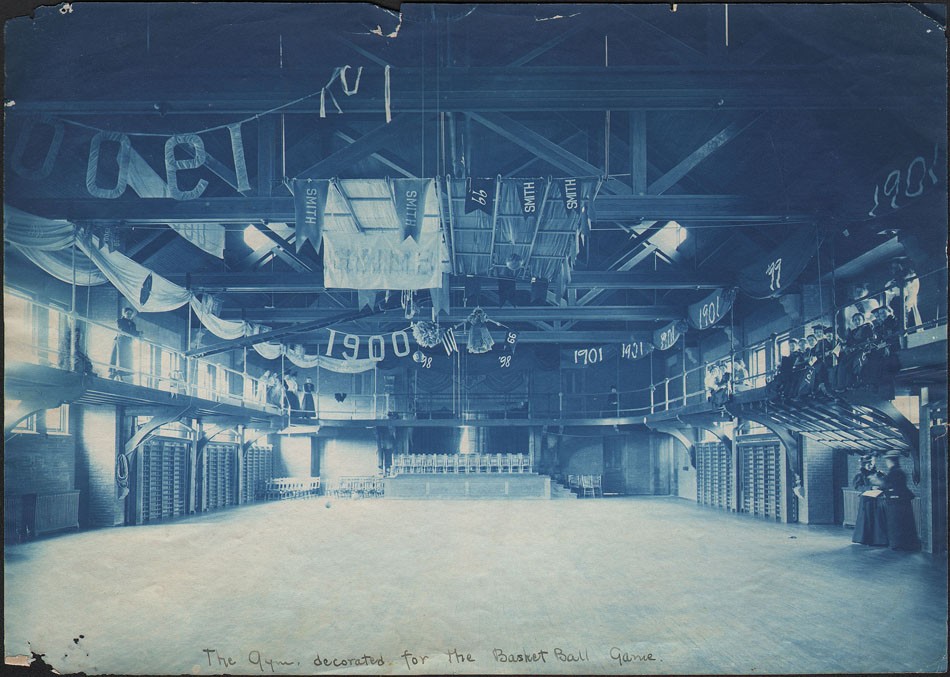 “The Gym, decorated for the Basket Ball Game” (Smith College: Northampton, Mass.) Unknown American commercial photographer: cyanotype: ca. 1898 (17.4 x 24.4 cm found loose within disassembled album with leaves each measuring 18.2 x 27.5 cm) Alumnae Gymnasium, opened in 1890, is shown decorated with bunting above the second level at left and at far right with the different class years represented: 98’, 99’, 1900, 1901. The occasion is believed to be a game between teams from the 1900 and 1901 classes, which took place on March 26, 1898. (1900 team won, 30-11⅓) In the early years when this photograph was taken around 1898, basketball as a women’s sport was played on the intramural level, with the various class years from the same college playing against each other. Wikipedia states Senda “Berenson herself opposed intercollegiate play for women, and prioritized the health and fitness benefits for a larger goal”. From: PhotoSeed Archive
“The Gym, decorated for the Basket Ball Game” (Smith College: Northampton, Mass.) Unknown American commercial photographer: cyanotype: ca. 1898 (17.4 x 24.4 cm found loose within disassembled album with leaves each measuring 18.2 x 27.5 cm) Alumnae Gymnasium, opened in 1890, is shown decorated with bunting above the second level at left and at far right with the different class years represented: 98’, 99’, 1900, 1901. The occasion is believed to be a game between teams from the 1900 and 1901 classes, which took place on March 26, 1898. (1900 team won, 30-11⅓) In the early years when this photograph was taken around 1898, basketball as a women’s sport was played on the intramural level, with the various class years from the same college playing against each other. Wikipedia states Senda “Berenson herself opposed intercollegiate play for women, and prioritized the health and fitness benefits for a larger goal”. From: PhotoSeed Archive
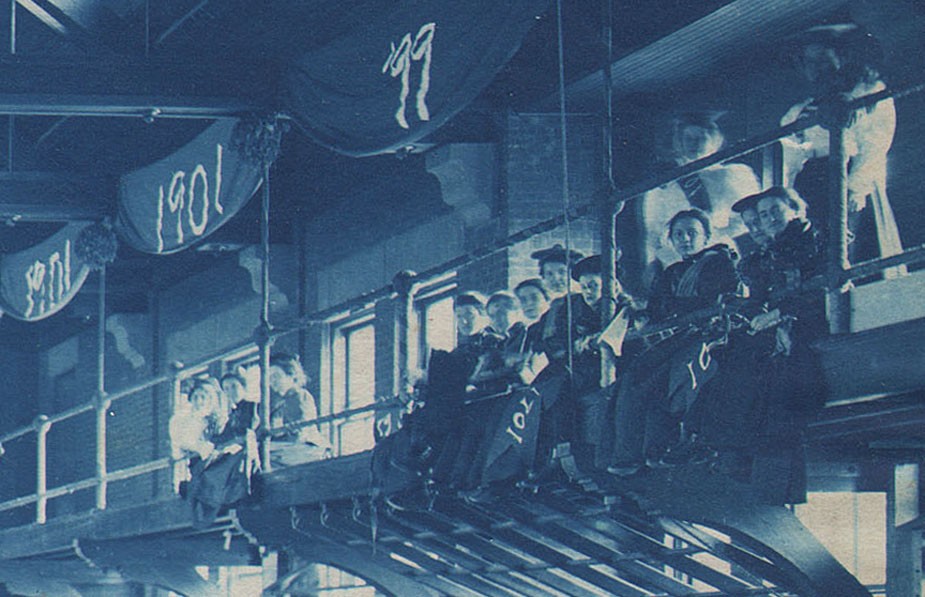 Detail: “The Gym, decorated for the Basket Ball Game” (Smith College: Northampton, Mass.) Unknown American commercial photographer: cyanotype: ca. 1898 (17.4 x 24.4 cm found loose within disassembled album with leaves each measuring 18.2 x 27.5 cm) Seated along a second level railing in Alumnae Gymnasium with their legs dangling over the side of the court are a group of women with one having a strong resemblance to Senda Berenson (third from right with 01 usher standing behind her) along with upperclassmen and most likely several teachers. From: PhotoSeed Archive
Detail: “The Gym, decorated for the Basket Ball Game” (Smith College: Northampton, Mass.) Unknown American commercial photographer: cyanotype: ca. 1898 (17.4 x 24.4 cm found loose within disassembled album with leaves each measuring 18.2 x 27.5 cm) Seated along a second level railing in Alumnae Gymnasium with their legs dangling over the side of the court are a group of women with one having a strong resemblance to Senda Berenson (third from right with 01 usher standing behind her) along with upperclassmen and most likely several teachers. From: PhotoSeed Archive
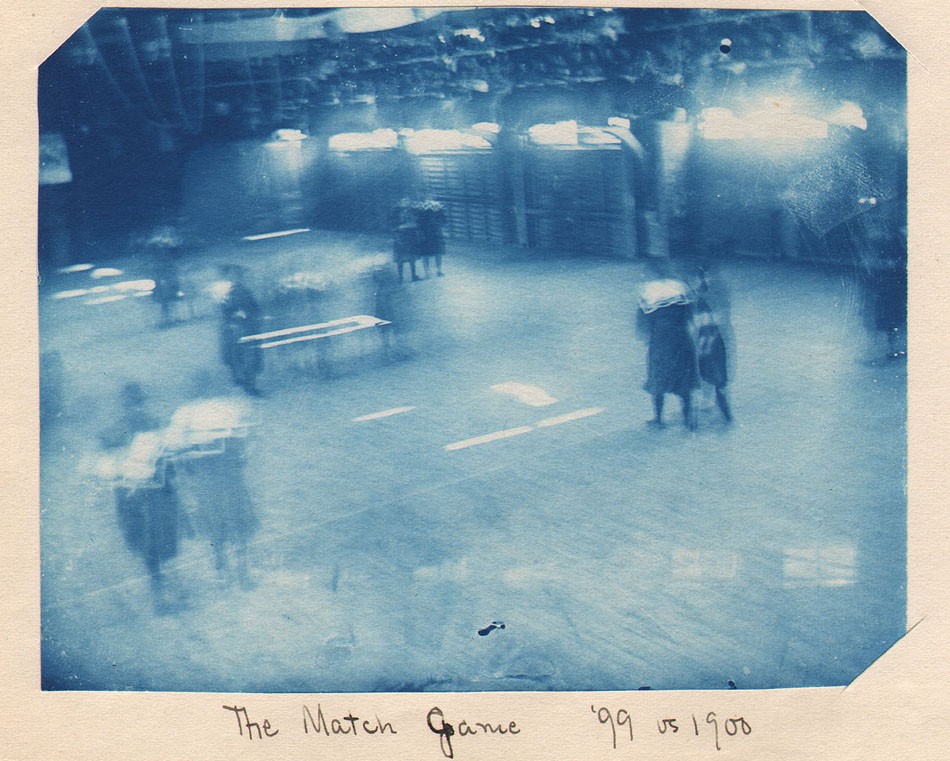 “The Match Game ’99 vs 1900” (Smith College: Northampton, Mass.) Unknown American photographer: cyanotype: ca. 1897 (9.6 x 12.2 cm | 18.2 x 27.5 cm loosely inserted within thin, manilla album leaf) This basketball game is believed to have been played on Saturday, March 27, 1897. This blurred view shows members of the Smith College class of 1899 and 1900 teams playing each other on the floor of Alumnae Gymnasium. The following description of some of the game rules were included in the article “Basket-Ball at Smith College” by Elizabeth Fisher Read published in The Outlook on September 26, 1896: “During the winter the games are played in the Alumnae Gymnasium. The floor of the gymnasium is marked off into three divisions, each of which forms the territory of a certain number of the players on each side. In each of the end divisions is a goal—an eighteen-inch cylinder or basket, the mouth of which is ten feet from the floor. The object of the game is to get the ball into the basket. At Smith a regulation Rugby football is used. Each basket is protected by three "homes"—players on the side to which that goal belongs, whose object is to get the ball into the basket. In the same territory stand three "guards," players on the other side, who try to prevent their opponents from scoring. In the middle division the "centers," four in number, play. The center players on each side try to get the ball when the referee puts it into play by tossing it out among them, and to pass it along from one member of the team to another, until it reaches the homes, and a goal is scored. The side scoring the most goals in forty minutes wins the game. The game is played in two halves of twenty minutes each, with ten minutes' intermission.” (p 557) From: PhotoSeed Archive
“The Match Game ’99 vs 1900” (Smith College: Northampton, Mass.) Unknown American photographer: cyanotype: ca. 1897 (9.6 x 12.2 cm | 18.2 x 27.5 cm loosely inserted within thin, manilla album leaf) This basketball game is believed to have been played on Saturday, March 27, 1897. This blurred view shows members of the Smith College class of 1899 and 1900 teams playing each other on the floor of Alumnae Gymnasium. The following description of some of the game rules were included in the article “Basket-Ball at Smith College” by Elizabeth Fisher Read published in The Outlook on September 26, 1896: “During the winter the games are played in the Alumnae Gymnasium. The floor of the gymnasium is marked off into three divisions, each of which forms the territory of a certain number of the players on each side. In each of the end divisions is a goal—an eighteen-inch cylinder or basket, the mouth of which is ten feet from the floor. The object of the game is to get the ball into the basket. At Smith a regulation Rugby football is used. Each basket is protected by three "homes"—players on the side to which that goal belongs, whose object is to get the ball into the basket. In the same territory stand three "guards," players on the other side, who try to prevent their opponents from scoring. In the middle division the "centers," four in number, play. The center players on each side try to get the ball when the referee puts it into play by tossing it out among them, and to pass it along from one member of the team to another, until it reaches the homes, and a goal is scored. The side scoring the most goals in forty minutes wins the game. The game is played in two halves of twenty minutes each, with ten minutes' intermission.” (p 557) From: PhotoSeed Archive
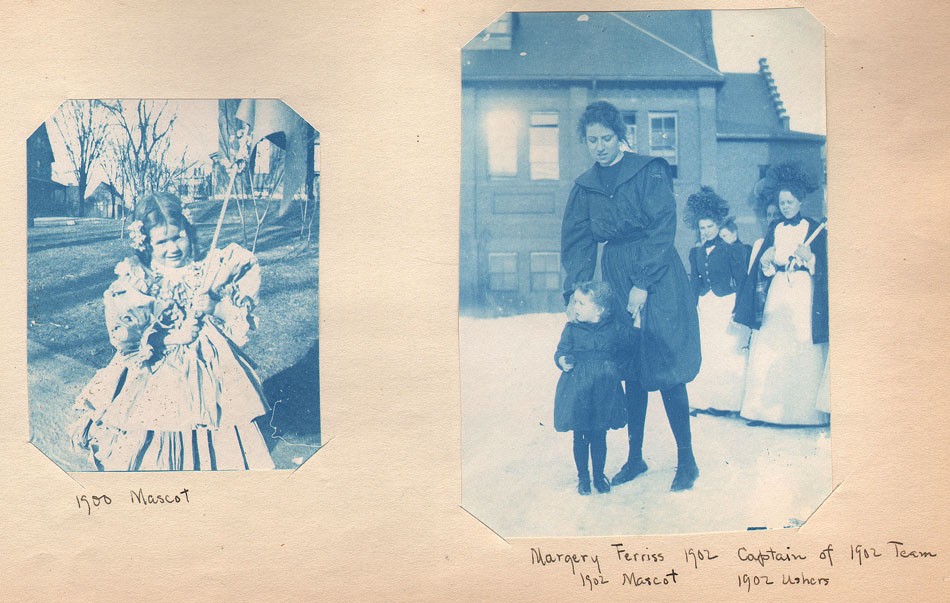 Left: “1900 Mascot” Right: “Margery Ferriss Captain of 1902 Team (along with) 1902 Mascot & 1902 Ushers” (Smith College: Northampton, Mass.) Unknown American photographer(s): cyanotype: ca. 1897-1899 (Left: 8.4 x 6.6 cm Right: 11.9 x 8.4 cm | 18.2 x 27.5 cm loosely inserted within thin, manilla album leaf) Team spirit for the new game of Basket Ball at Smith was ever present, with fans and students wearing distinctive colors on the big day. Each class even had their own “Mascot” : a young child dressed up for the occasion. At left, the 1900 class mascot wears a fancy child’s dress while holding a banner. By 1902, team captain Margery Ferriss, standing in front of Alumnae Gym, holds the hand of the class year Mascot, sporting a miniature version of the team outfit that she herself wears. The following description of game spirit at Smith was included in the article “Basket-Ball at Smith College” by Elizabeth Fisher Read published in The Outlook on September 26, 1896: “While waiting for the teams to come out, the students while away the time by singing songs gotten up for the occasion. These songs consist of lines appropriate to the situation, in praise of the class or the team, set to some popular melody. From time to time both sides join in singing some song of general interest. As each member of the Faculty comes in, he is greeted with cheers and with his verse of the "Faculty song." During the actual playing no singing is permitted, but in the intermission it is renewed with increased vigor, the winning side trying to express their approval and pleasure, the losers trying to cheer up their team to greater efforts. After the game cheers, songs, and a triumphal parade end the contest.” (p. 558) From: PhotoSeed Archive
Left: “1900 Mascot” Right: “Margery Ferriss Captain of 1902 Team (along with) 1902 Mascot & 1902 Ushers” (Smith College: Northampton, Mass.) Unknown American photographer(s): cyanotype: ca. 1897-1899 (Left: 8.4 x 6.6 cm Right: 11.9 x 8.4 cm | 18.2 x 27.5 cm loosely inserted within thin, manilla album leaf) Team spirit for the new game of Basket Ball at Smith was ever present, with fans and students wearing distinctive colors on the big day. Each class even had their own “Mascot” : a young child dressed up for the occasion. At left, the 1900 class mascot wears a fancy child’s dress while holding a banner. By 1902, team captain Margery Ferriss, standing in front of Alumnae Gym, holds the hand of the class year Mascot, sporting a miniature version of the team outfit that she herself wears. The following description of game spirit at Smith was included in the article “Basket-Ball at Smith College” by Elizabeth Fisher Read published in The Outlook on September 26, 1896: “While waiting for the teams to come out, the students while away the time by singing songs gotten up for the occasion. These songs consist of lines appropriate to the situation, in praise of the class or the team, set to some popular melody. From time to time both sides join in singing some song of general interest. As each member of the Faculty comes in, he is greeted with cheers and with his verse of the "Faculty song." During the actual playing no singing is permitted, but in the intermission it is renewed with increased vigor, the winning side trying to express their approval and pleasure, the losers trying to cheer up their team to greater efforts. After the game cheers, songs, and a triumphal parade end the contest.” (p. 558) From: PhotoSeed Archive
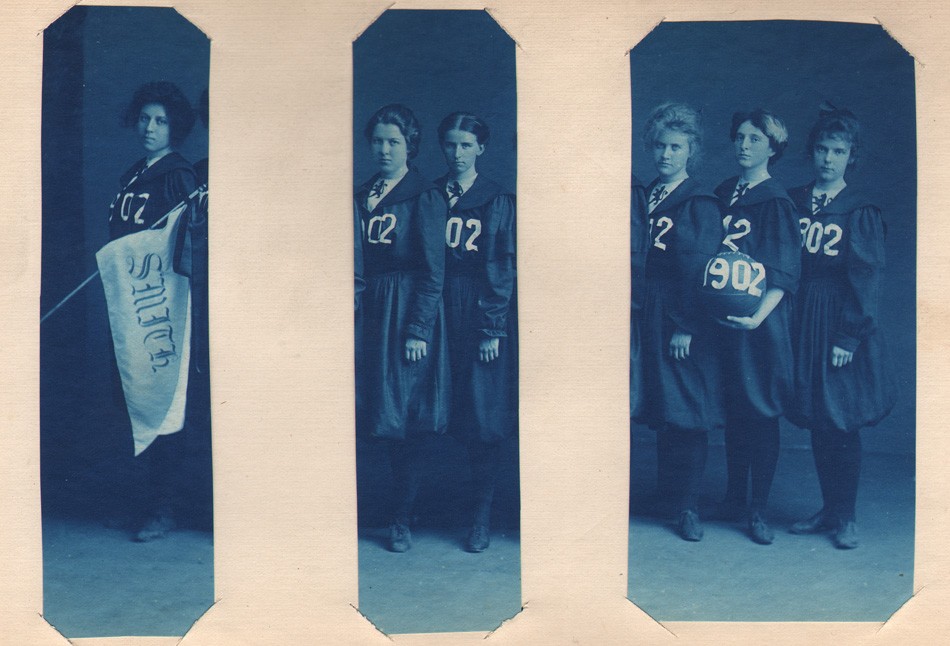 “1902 Freshman Basket-Ball Team” (Smith College: Northampton, Mass.) Unknown American commercial photographer (possibly Amand Joseph “A.J.” Schillare: 1856-1917 of Northampton who advertised “groups and dramatics a specialty” in the 1899 Class Book): cyanotype presented as triptych within album leaf : ca. 1898 (Left: 13.2 x 3.6 cm Middle: 13.1 x 3.4 cm | Right: 12.6 x 6.0 cm | 18.2 x 27.5 cm thin, manilla album leaf) In this unusual variant from one published featuring 11 players in the 1902 Smith Class Book, only six players are shown. At far left, team captain Margery Ferriss holds the Smith pennant. Margery May Ferriss Semple (1880-1950) was originally from St. Louis, MO. 1902 team members were: Homes: Juliet Patten, Constance Patton, Helen Walbridge; Guards: Margery Ferriss, Harriet Emmons, Louise Vanderbilt; Centres: Eda Bruné, Agnes Inglis, Mary Glover, Katherine Harter. From: PhotoSeed Archive
“1902 Freshman Basket-Ball Team” (Smith College: Northampton, Mass.) Unknown American commercial photographer (possibly Amand Joseph “A.J.” Schillare: 1856-1917 of Northampton who advertised “groups and dramatics a specialty” in the 1899 Class Book): cyanotype presented as triptych within album leaf : ca. 1898 (Left: 13.2 x 3.6 cm Middle: 13.1 x 3.4 cm | Right: 12.6 x 6.0 cm | 18.2 x 27.5 cm thin, manilla album leaf) In this unusual variant from one published featuring 11 players in the 1902 Smith Class Book, only six players are shown. At far left, team captain Margery Ferriss holds the Smith pennant. Margery May Ferriss Semple (1880-1950) was originally from St. Louis, MO. 1902 team members were: Homes: Juliet Patten, Constance Patton, Helen Walbridge; Guards: Margery Ferriss, Harriet Emmons, Louise Vanderbilt; Centres: Eda Bruné, Agnes Inglis, Mary Glover, Katherine Harter. From: PhotoSeed Archive
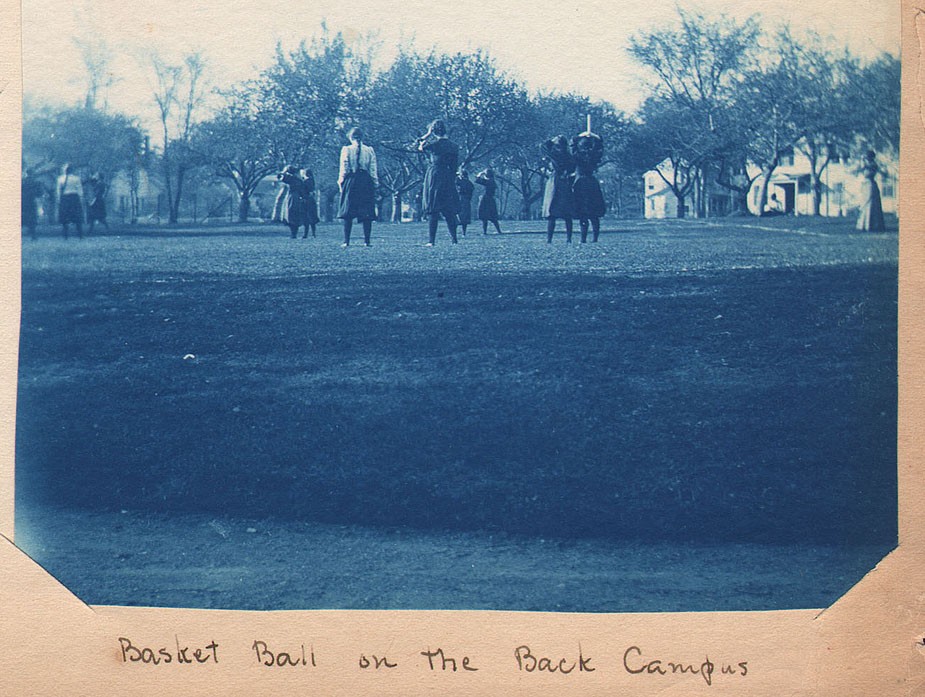 “Basket Ball on the Back Campus” (Smith College: Northampton, Mass.) Unknown American photographer: cyanotype: ca. 1898-1900 (9.1 x 11.7 cm | 18.2 x 27.5 cm loosely inserted within thin, manilla album leaf) It is unclear if this view shows a basketball game in progress or perhaps a practice, since no goals are seen. The student at front right holds some type of cylinder on top of her head-possibly signifying the placement for where the goal would be located? The following description describes basketball played during the Spring at Smith, included in the article “Basket-Ball at Smith College” by Elizabeth Fisher Read published in The Outlook on September 26, 1896: “In the spring the playing is done on a ground laid out on the campus. The pictures accompanying this article were taken on this out-of-door ground. The gymnasium suit shown in the pictures is the dress worn by all the gymnasium classes. It consists of a blouse with Turkish trousers. These out-of-door games are very popular with the students. The ground is nearly always surrounded by interested spectators when a game is going on.” (p. 558) From: PhotoSeed Archive
“Basket Ball on the Back Campus” (Smith College: Northampton, Mass.) Unknown American photographer: cyanotype: ca. 1898-1900 (9.1 x 11.7 cm | 18.2 x 27.5 cm loosely inserted within thin, manilla album leaf) It is unclear if this view shows a basketball game in progress or perhaps a practice, since no goals are seen. The student at front right holds some type of cylinder on top of her head-possibly signifying the placement for where the goal would be located? The following description describes basketball played during the Spring at Smith, included in the article “Basket-Ball at Smith College” by Elizabeth Fisher Read published in The Outlook on September 26, 1896: “In the spring the playing is done on a ground laid out on the campus. The pictures accompanying this article were taken on this out-of-door ground. The gymnasium suit shown in the pictures is the dress worn by all the gymnasium classes. It consists of a blouse with Turkish trousers. These out-of-door games are very popular with the students. The ground is nearly always surrounded by interested spectators when a game is going on.” (p. 558) From: PhotoSeed Archive
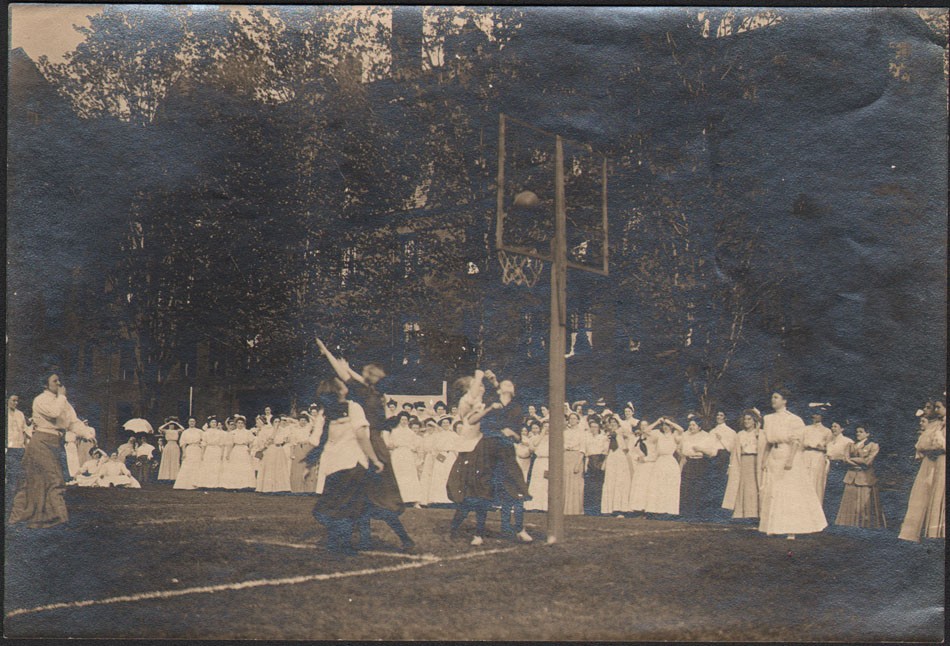 “Women’s outdoor Basket Ball Game: New England or Mid-Atlantic States” Unknown American photographer: gelatin silver print: ca. 1905-10 (11.4 x 17.0 cm - photograph enclosed within gummed manilla postal envelope engraved with spot hand-coloring on recto: “Kodak shots and postal cards Of many a pleasant view - Will bring the golden memories back Of happy days to you”) A rare surviving photograph featuring outdoor basketball action between two women’s collegiate teams is shown. Notice the ball aloft just above one of the suspended nets near the center of the composition, featuring an open-style backboard. A throng of fashionably dressed young women (and a lone gentleman) watch and cheer on the sidelines in the background. This game may have taken place as part of popular “Field Day” exercises colleges were known to host in the early Spring. Women’s basketball as a sport that in turn promoted good physical conditioning may have started at Smith in the early 1890’s but soon spread rapidly around the country: “Soon thereafter women at Wellesley, Vassar, Radcliff, and other women’s colleges and “normal schools” in the Northeast took up the sport. It was only a matter of time before basketball was being played by girls and women at high schools and colleges across America-including Montana.” (Source: “The Girls’ Basketball Team from Fort Shaw” by Linda Peavy and Ursula Smith in: Native Athletes in Sport and Society: edited by C. Richard King: University of Nebraska Press, 2005. (p. 44) From: PhotoSeed Archive
“Women’s outdoor Basket Ball Game: New England or Mid-Atlantic States” Unknown American photographer: gelatin silver print: ca. 1905-10 (11.4 x 17.0 cm - photograph enclosed within gummed manilla postal envelope engraved with spot hand-coloring on recto: “Kodak shots and postal cards Of many a pleasant view - Will bring the golden memories back Of happy days to you”) A rare surviving photograph featuring outdoor basketball action between two women’s collegiate teams is shown. Notice the ball aloft just above one of the suspended nets near the center of the composition, featuring an open-style backboard. A throng of fashionably dressed young women (and a lone gentleman) watch and cheer on the sidelines in the background. This game may have taken place as part of popular “Field Day” exercises colleges were known to host in the early Spring. Women’s basketball as a sport that in turn promoted good physical conditioning may have started at Smith in the early 1890’s but soon spread rapidly around the country: “Soon thereafter women at Wellesley, Vassar, Radcliff, and other women’s colleges and “normal schools” in the Northeast took up the sport. It was only a matter of time before basketball was being played by girls and women at high schools and colleges across America-including Montana.” (Source: “The Girls’ Basketball Team from Fort Shaw” by Linda Peavy and Ursula Smith in: Native Athletes in Sport and Society: edited by C. Richard King: University of Nebraska Press, 2005. (p. 44) From: PhotoSeed Archive
✻ The provenance for these photographs with the exception of the final one taken outdoors were part of a disassembled album that formerly belonged to Mary Ruth Perkins, a 1900 graduate of Smith who was Chairman of the 1900 class yearbook committee. Three students are given credit in the 1900 Class Book as having contributed photographs: Alma Hoegh, Cornelia Amey Kingman, Ora Mabelle Lewis.
Making a Pitch
Posted April 2017 in History of Photography, New Additions, Sports Photography
Like hot dogs, apple pie and a certain car company, the time-honored pastime of American baseball is once again upon us this spring in big league parks and dusty diamonds scattered throughout the land.
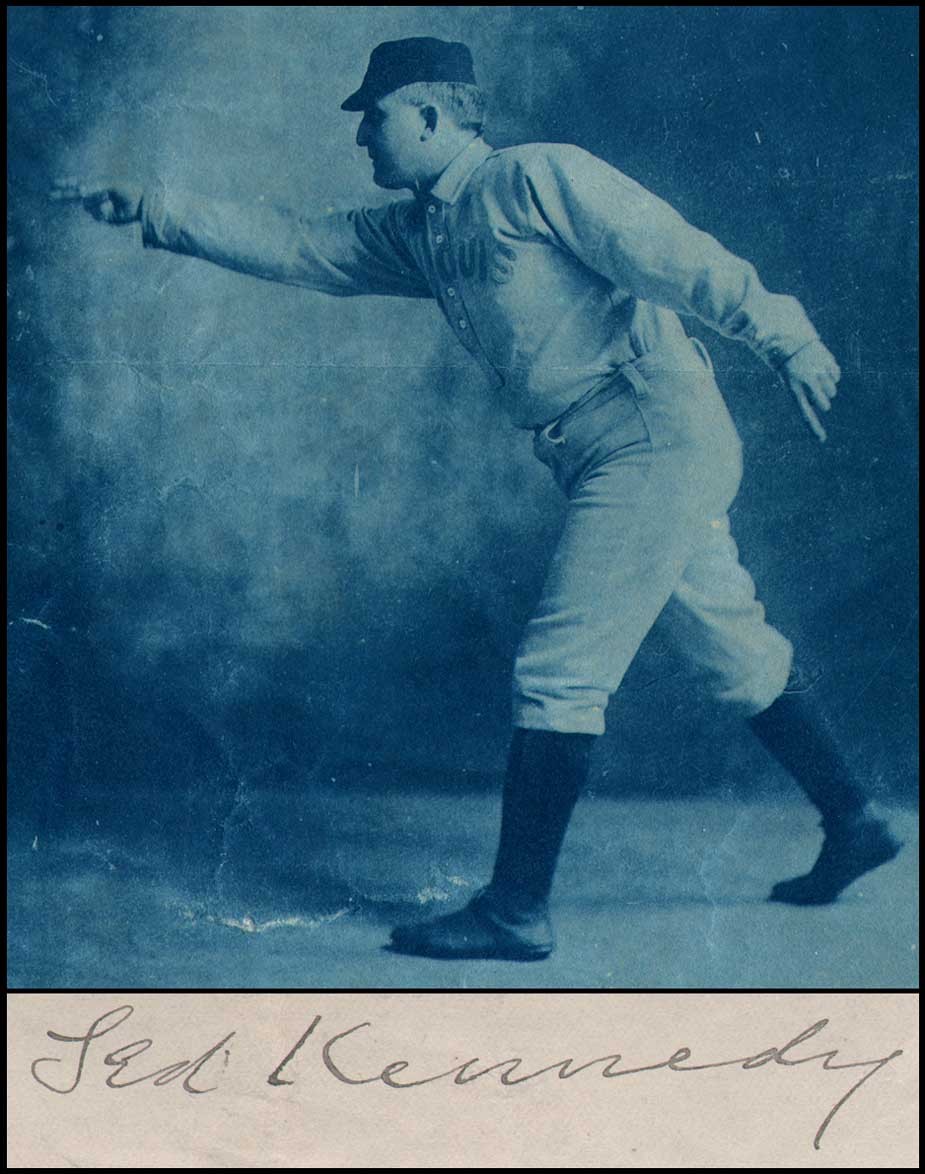 Detail: Top: "Ted Kennedy Throws a Curveball": ca. 1905: vintage cyanotype, unmounted: 17.6 x 12.5 cm: American Major League Baseball Pitcher Ted Kennedy, 1865-1907, demonstrates following through while throwing an overhand curve ball. Shown wearing his St. Louis Browns baseball uniform, Kennedy excelled in the American spirit of being an entrepreneur, inventor and promoter long after his playing days, and was the first ever hitting coach in the Majors. Bottom: Detail: verso autograph from "Ted Kennedy" cyanotype in graphite believed to be genuine: app: 1.0 x 8.5 cm. From: PhotoSeed Archive
Detail: Top: "Ted Kennedy Throws a Curveball": ca. 1905: vintage cyanotype, unmounted: 17.6 x 12.5 cm: American Major League Baseball Pitcher Ted Kennedy, 1865-1907, demonstrates following through while throwing an overhand curve ball. Shown wearing his St. Louis Browns baseball uniform, Kennedy excelled in the American spirit of being an entrepreneur, inventor and promoter long after his playing days, and was the first ever hitting coach in the Majors. Bottom: Detail: verso autograph from "Ted Kennedy" cyanotype in graphite believed to be genuine: app: 1.0 x 8.5 cm. From: PhotoSeed Archive
Seen here making his pitch is Ted Kennedy, (1865-1907) one of the game’s early promoters whose playing days lasted a mere two years from 1885-86, pitching for teams including the Chicago White Stockings, Philadelphia Athletics and Louisville Colonels. Play Ball!